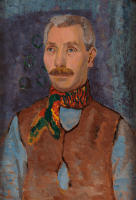

Frank Dobson
(1888-1963) The BatmanProvenance
Private Collection, U.K.
We are grateful to Jacqui Ansell, Senior Lecturer Christie’s Education, for her commentary on men’s fashion which has been incorporated into this catalogue note.
This rare example of Frank Dobson’s painted portraiture depicts a military ‘batman’ executed during the First World War, before he turned increasingly toward sculpture as his main artistic practice.
Practical and hardwearing, this man’s garments befit his active role as a ‘batman’. This peculiar military term fits many different roles of ‘gentlemen’s gentlemen’ but generally refers to a soldier or airman assigned to a commissioned officer as a personal servant or trusted ‘right-hand man’. Given the date of the portrait, it seems reasonable to infer that this man, with his military moustache and sleeveless leather jerkin, might have served an officer. However, this sitter has not abandoned his individuality amongst the uniformity of military life; the brightly coloured neckerchief is a focal point in this portrait, as it would have been in real life....
We are grateful to Jacqui Ansell, Senior Lecturer Christie’s Education, for her commentary on men’s fashion which has been incorporated into this catalogue note.
This rare example of Frank Dobson’s painted portraiture depicts a military ‘batman’ executed during the First World War, before he turned increasingly toward sculpture as his main artistic practice.
Practical and hardwearing, this man’s garments befit his active role as a ‘batman’. This peculiar military term fits many different roles of ‘gentlemen’s gentlemen’ but generally refers to a soldier or airman assigned to a commissioned officer as a personal servant or trusted ‘right-hand man’. Given the date of the portrait, it seems reasonable to infer that this man, with his military moustache and sleeveless leather jerkin, might have served an officer. However, this sitter has not abandoned his individuality amongst the uniformity of military life; the brightly coloured neckerchief is a focal point in this portrait, as it would have been in real life.
Coloured cotton handkerchiefs had been worn around the neck by working men and women as far back as the eighteenth century and served a practical function - they could be used to mop the sweat of the brow, as well as to provide an easily washable extra layer of clothing. Through his sitter’s fashion choices, Dobson captures a subtle hint of this military man’s free will and idiosyncratic personality.
Well versed in military life, early in 1915 Dobson enlisted in the Artists' Rifles and in October 1916 was posted to France, where he was a lieutenant in the 5th Border regiment. In 1916, the same year as this painting, his battalion was posted to France to reinforce troops fighting in the Somme. He experienced stomach issues almost as soon as he arrived and was later sent home from the front line with what Dobson later described as ‘shell shock’.











